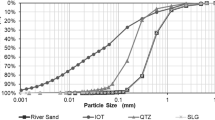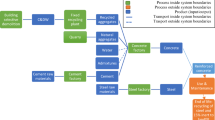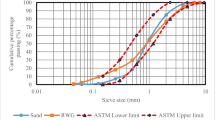Abstract
Purpose
This study used the life cycle assessment (LCA) methodology (ISO 14040, ISO 14044) to quantify and compare the environmental impacts associated with the production of masonry mortar manufactured with different amounts of natural fine aggregate (NFA), recycled fine aggregate (RFA) from construction and demolition waste (C&DW), and admixture. The study also analyzed and compared the production processes for fine aggregates (natural and recycled) in order to determine the associated benefit of using RFA from C&DW instead of NFA.
Methods
The system boundaries were considered from cradle to gate level and included the production of raw materials, transport to the mortar plant, and the manufacture of 1 t functional unit of dry masonry mortar. Foreground data were site specific and collected by means of surveys, interviews, and technical visits to the local producers (Spain). Inventory data were loaded into the SimaPro software and processed using the CML-IA and ILCD methods. Uncertainty analysis was conducted using the Monte Carlo method to verify the uncertainty related to the data variability for both foreground and background inventory data. Also, a series of sensitivity analyses were performed to determine how changes in the transport distances of C&DW and the type of truck would alter the results of the LCA.
Results and discussion
The results showed that using RFA helped diminish environmental burdens in almost all the impact categories due to the avoidance of impacts arising from the transport and disposal of C&DW in landfills. The impacts increased slightly in ecotoxicity due to the fact that the transport distance of RFA was greater than the transport distance of NFA. The uncertainty analysis suggested a high level of accuracy for the majority of the impact categories. Furthermore, the sensitivity analysis determined how distances and transport processes influenced the environmental impact of masonry mortars so that the greater the transport distance of C&DW from site of generation to treatment plant and the smaller the transport distance to landfill, the greater the environmental burdens.
Conclusions
This study has clearly shown the environmental benefits which arise from using RFA from C&DW as secondary raw material for the production of masonry mortar, thereby contributing to the circular economy. Nevertheless, in order to be able to quantify the environmental benefit generated by the recycling of C&DW, it is extremely important that the processes avoided, such as the transport and disposal of C&DW in landfill, are taken into account in life cycle assessment studies.







Similar content being viewed by others
Abbreviations
- A:
-
Acidification of soil and water
- ADe:
-
Abiotic depletion of elements
- ADf:
-
Abiotic depletion of fossil fuels
- C&DW:
-
Construction and demolition waste
- COD:
-
Chemical oxygen demand
- E:
-
Eutrophication
- EPD:
-
Environmental Product Declaration
- ET:
-
Ecotoxicity
- GW:
-
Global warming
- HTc:
-
Human toxicity for cancer effects
- HTnc:
-
Human toxicity for non-cancer effects
- LCA:
-
Life cycle assessment
- LU:
-
Land use
- NA:
-
Natural aggregates
- NFA:
-
Natural fine aggregates
- ODP:
-
Ozone layer depletion
- PM:
-
Particulate matter
- POF:
-
Photochemical oxidation
- RA:
-
Recycled aggregates
- RFA:
-
Recycled fine aggregates
- WD:
-
Water depletion
References
Alphabet Inc (2016) Google Maps. https://maps.google.com
ANEFA (2016) El sector de los áridos en 2015. In: Asoc. Nac. Empres. Fabr. áridos en España. http://www.aridos.org/wp-content/uploads/2016/06/El-sector-de-los-Áridos-en-2015.pdf. Accessed 16 Dec 2016
Bektas F, Wang K, Ceylan H (2009) Effects of crushed clay brick aggregate on mortar durability. Constr Build Mater 23:1909–1914
Blengini GA, Garbarino E (2010) Resources and waste management in Turin (Italy): the role of recycled aggregates in the sustainable supply mix. J Clean Prod 18:1021–1030
Bovea MD, Powell JC (2016) Developments in life cycle assessment applied to evaluate the environmental performance of construction and demolition wastes. Waste Manag 50:151–172
Butera S, Christensen TH, Astrup TF (2015) Life cycle assessment of construction and demolition waste management. Waste Manag 44:196–205
CEN (2002) European Standard EN 13139. Aggregates for mortar. European Committee for Standardization, Bruxelles
CEN (2009) European Standard EN 933-11. Tests for geometrical properties of aggregates. Part 11: classification test for the constituents of coarse recycled aggregate. European Committee for Standardization, Bruxelles
CEN (2012) European Standard EN 998-2. Specification for mortar for masonry. Part 2: masonry mortar. European Committee for Standardization, Bruxelles
CEN (2013) European Standard EN 15804+A1. Sustainability of construction works. Environmental product declarations. Core rules for the product category of construction products. European Committee for Standardization, Bruxelles
Clarivate Analytics (2017) Web of Science. https://apps.webofknowledge.com/WOS_GeneralSearch_input.do?product=WOS&search_mode=GeneralSearch&SID=E2qTHU8TmWnr6XptbgC&preferencesSaved=. Accessed 1 Jun 2017
Coelho A, De Brito J (2012) Influence of construction and demolition waste management on the environmental impact of buildings. Waste Manag 32:357–358
Corinaldesi V, Moriconi G (2009) Behaviour of cementitious mortars containing different kinds of recycled aggregate. Constr Build Mater 23:289–294
Cuenca-Moyano GM, Martín-Morales M, Valverde-Palacios I, Valverde-Espinosa I, Zamorano M (2014) Influence of pre-soaked recycled fine aggregate on the properties of masonry mortar. Constr Build Mater 70:71–79
Cuenca-Moyano GM, Zanni S, Bonoli A, Valverde-Palacios I (2017) Development of the life cycle inventory of masonry mortar made of natural and recycled aggregates. J Clean Prod 140(Part 3):1272–1286
Dahlbo H, Bachér J, Lähtinen K, Jouttijärvi T, Suoheimo P, Mattila T, Sironen S, Myllymaa T, Saramäki K (2015) Construction and demolition waste management - a holistic evaluation of environmental performance. J Clean Prod 107:333–341
EC-JRC-IES (2012) Characterisation factors of the ILCD Recommended Life Cycle Impact Assessment methods, Database and Supporting Information, First edit. EUR 25167 Publications Office of the European Union, Luxembourg
Ecoinvent (2014) Ecoinvent v3.0.1, Life cycle inventories of production systems. Swiss Centre for Life Cycle Inventories
EFCA (2006) Environmental declaration plasticising admixtures. http://www.efca.info/downloads/324 ETG Plasticiser EPD.pdf. Accessed 28 Jul 2015
Elsevier B.V. (2017) Scopus. https://www.scopus.com. Accessed 1 Jun 2017
Estanqueiro B, Silvestre JD, de Brito J, Pinheiro MD (2016) Environmental life cycle assessment of coarse natural and recycled aggregates for concrete. Eur J Environ Civ Eng 22(4):429–449
Etxeberria M, Vázquez E, Marí A, Barra M (2007) Influence of amount of recycled coarse aggregates and production process on properties of recycled aggregate concrete. Cem Concr Res 37:735–742
European Commission (2011) Roadmap to a Resource Efficient Europe (COM 571)
European Commission (2014a) Towards a circular economy: a zero waste programme for Europe (COM398)
European Commission (2014b) On resource efficiency opportunities in the building sector (COM 445). 1–10
European Parliament and Council (2008) Directive 2008/98/EC of 19 November 2008 on waste
Eurostat (2017) European Statistics. Statistical Office of the European Communities. http://ec.europa.eu/eurostat/data/database. Accessed 13 Mar 2018
Ferreira VJ, Sáez-De-Guinoa Vilaplana A, García-Armingol T et al (2016) Evaluation of the steel slag incorporation as coarse aggregate for road construction: technical requirements and environmental impact assessment. J Clean Prod 130:175–186
Frischknecht R, Jungbluth N, Althaus H-J, Doka G, Dones R, Heck T, Hellweg S, Hischier R, Nemecek T, Rebitzer G, Spielmann M (2005) The ecoinvent Database: Overview and Methodological Framework (7 pp). Int J Life Cycle Assess 10(1):3–9
Frondistou-Yannas S (1977) Waste concrete as aggregate for new concrete. ACI J 74:373–376
Guinée JB, Gorrée M, Heijungs R et al (2002) Handbook on life cycle assessment, operational guide to the ISO standards, I: LCA in perspective, IIa: guide, IIb: operational annex, III: scientific background. Kluwer Academic Publishers, Dordrecht
Hansen TC, Narud H (1983) Strength of recycled concrete made from crushed concrete coarse aggregate. Concr Int 5:79–83
Hauschild M, Potting J (2003) Spatial differentiation in Life Cycle impact assessment - The EDIP2003 methodology. Institute for Product Development Technical University of Denmark
Hossain MU, Poon CS, Lo IMC, Cheng JCP (2016a) Evaluation of environmental friendliness of concrete paving eco-blocks using LCA approach. Int J Life Cycle Assess 21:70–84
Hossain MU, Poon CS, Lo IMC, Cheng JCP (2016b) Comparative environmental evaluation of aggregate production from recycled waste materials and virgin sources by LCA. Resour Conserv Recycl 109:67–77
Huijbregts MAJ, Hellweg S, Frischknecht R, Hendriks HWM, Hungerbühler K, Hendriks AH (2010) Cumulative Energy Demand As Predictor for the Environmental Burden of Commodity Production. Environ Sci Technol 44(6):2189–2196
Huntzinger DN, Eatmon TD (2009) A life-cycle assessment of Portland cement manufacturing: comparing the traditional process with alternative technologies. J Clean Prod 17:668–675
ISO (2006a) ISO 14040. Environmental management - life cycle assessment - principles and framework. International Organization for Standardization, Geneva
ISO (2006b) ISO 14044. Environmental management - life cycle assessment - requirements and guidelines. International Organization for Standardization, Geneva
Jiménez JR, Ayuso J, López M, Fernández JM, de Brito J (2013) Use of fine recycled aggregates from ceramic waste in masonry mortar manufacturing. Constr Build Mater 40:679–690
Jolliet O, Fanke P (2015) Human toxicity. In: Hauschild MZ, Huijbregts MAJ (eds) Life cycle impact assessment, LCA compendium – the complete world of life cycle assessment. Springer Science+Business Media, Dordrecht, pp 75–96
Jolliet O, Margni M, Charles R, Humbert S, Payet J, Rebitzer G, Rosenbaum R (2003) IMPACT 2002+: A new life cycle impact assessment methodology. Int J Life Cycle Assess 8(6):324–330
Knoeri C, Sanyé-Mengual E, Althaus H-J (2013) Comparative LCA of recycled and conventional concrete for structural applications. Int J Life Cycle Assess 18:909–918
Marinković S, Radonjanin V, Malešev M, Ignjatović I (2010) Comparative environmental assessment of natural and recycled aggregate concrete. Waste Manag 30:2255–2264
Martín-Morales M, Cuenca-Moyano GM, Zamorano M, Valverde-Palacios I (2013a) Recycled aggregate in road construction following the Spanish general technical specifications for roads and bridge works (PG-3): a case study. Inf Constr 65:107–119. https://doi.org/10.3989/ic.11.125
Martín-Morales M, Zamorano M, Valverde-Palacios I, Cuenca-Moyano GM, Sánchez-Roldán Z (2013b) Quality control of recycled aggregates (RAs) from construction and demolition waste (CDW). In: Pacheco-Torgal F, Tam V, Labrincha J et al (eds) Handbook of recycled concrete and demolition waste. Woodhead Publishing Limited, Cambrigde, pp 270–303
Martín-Morales M, Cuenca-Moyano GM, Valverde-Espinosa I, Valverde-Palacios I (2017) Effect of recycled aggregate on physical-mechanical properties and durability of vibro-compacted dry-mixed concrete hollow blocks. Constr Build Mater 145:303–310
Melià P, Ruggieri G, Sabbadini S, Dotelli G (2014) Environmental impacts of natural and conventional building materials: a case study on earth plasters. J Clean Prod 80:179–186
Mendes Moraes CA, Kieling AG, Caetano MO, Gomes LP (2010) Life cycle analysis (LCA) for the incorporation of rice husk ash in mortar coating. Resour Conserv Recycl 54:1170–1176
Mercante IT, Bovea MD, Ibanez-Fores V et al (2012) Life cycle assessment of construction and demolition waste management systems: a Spanish case study. Int J Life Cycle Assess 17:232–241
Mickovski SB, Buss K, McKenzie BM, Sökmener B (2013) Laboratory study on the potential use of recycled inert construction waste material in the substrate mix for extensive green roofs. Ecol Eng 61:706–714
Ministerio de la Presidencia (2016) Real Decreto 256/2016, de 10 de Junio, por el que se aprueba la Instrucción para la recepción de cementos (RC-16). Boletín Of del Estado 153:45755–45824
Molineux CJ, Gange AC, Connop SP, Newport DJ (2015) Using recycled aggregates in green roof substrates for plant diversity. Ecol Eng 82:596–604
Mroueh UM, Laine-Ylijoki J, Eskola P (2000) Life-cycle impacts of the use of industrial by-products in road and earth construction. Waste Manag 1:438–448
Ortiz O, Pasqualino JC, Castells F (2010) Environmental performance of construction waste: comparing three scenarios from a case study in Catalonia, Spain. Waste Manag 30:646–654
Penteado CSG, Rosado LP (2016) Comparison of scenarios for the integrated management of construction and demolition waste by life cycle assessment: a case study in Brazil. Waste Manag Res 34:1026–1035
Poon CS, Chan D (2006) Feasible use of recycled concrete aggregates and crushed clay brick as unbound road sub-base. Constr Build Mater 20:578–585
PRé Consultants (2014) SimaPro 8.0.2, LCA Software and Database Manual
Rebitzer G, Ekvall T, Frischknecht R, Hunkeler D, Norris G, Rydberg T, Schmidt WP, Suh S, Weidema BP, Pennington DW (2004) Life cycle assessment part 1: framework, goal and scope definition, inventory analysis, and applications. Environ Int 30:701–720
Rosenbaum RK (2015) Ecotoxicity. In: Hauschild MZ, Huijbregts MAJ (eds) Life cycle impact assessment, LCA compendium – the complete world of life cycle assessment. Springer Science+Business Media, Dordrecht, pp 139–162
Ruello ML, Amato A, Beolchini F, Monosi S (2016) Valorizing end-of-life LCD scraps after indium recovery. Phys Status Solidi 13:1011–1016
Sánchez-Roldán Z, Martín-Morales M, Valverde-Palacios I, Valverde-Espinosa I, Zamorano M (2016) Study of potential advantages of pre-soaking on the properties of pre-cast concrete made with recycled coarse aggregate. Mater Constr 66:e076. https://doi.org/10.3989/mc.2016.01715
Serres N, Braymand S, Feugeas F (2016) Environmental evaluation of concrete made from recycled concrete aggregate implementing life cycle assessment. J Build Eng 5:24–33
Simion IM, Fortuna ME, Bonoli A, Gavrilescu M (2013) Comparing environmental impacts of natural inert and recycled construction and demolition waste processing using LCA. J Environ Eng Landsc Manag 21:273–287
Spanish Association of Recycling of Construction and Demolition Wastes (2017) Report on production and management of construction and demolition waste in Spain 2011–2015. pp 1–52
Swart P, Alvarenga RAF, Dewulf J (2015) Abiotic resource use. In: Hauschild MZ, Huijbregts MAJ (eds) Life cycle impact assessment, LCA compendium – the complete world of life cycle assessment. Springer Science+Business Media, Dordrecht, pp 247–270
Turk J, Cotic Z, Mladenovic A, Sajna A (2015) Environmental evaluation of green concretes versus conventional concrete by means of LCA. Waste Manag 45:194–205
UEPG (2016) A sustainable industry for a sustainable Europe. Annual Review 2015–2016. http://www.uepg.eu/uploads/Modules/Publications/uepg-ar2016-17_32pages_v04_small.pdf. Accessed 15 Dec 2016
Valverde-Espinosa I (1992) Caracterización de aridos para hormigón en la depresión de Granada. Universidad de Granada
Vegas I, Ibañez JA, Lisbona A, Sáez de Cortazar A, Frías M (2011) Pre-normative research on the use of mixed recycled aggregates in unbound road sections. Constr Build Mater 25:2674–2682
Vossberg C, Mason-Jones K, Cohen B (2014) An energetic life cycle assessment of C&D waste and container glass recycling in Cape Town, South Africa. Resour Conserv Recycl 88:39–49
Yazdanbakhsh A, Bank LC, Baez T, Wernick I (2018) Comparative LCA of concrete with natural and recycled coarse aggregate in the New York City area. Int J Life Cycle Assess 23:1163–1173
Zabalza-Bribián I, Valero-Capilla A, Aranda-Usón A (2011) Life cycle assessment of building materials: comparative analysis of energy and environmental impacts and evaluation of the eco-efficiency improvement potential. Build Environ 46:1133–1140
Acknowledgements
We would like to thank the staff of ARGOS D.C. (Padul, Spain), INERTES GUHILAR S.L. (Alhendín, Spain), and ÁRIDOS LOS LINOS (Padul, Spain) for their help in this study, and also the Department of Civil, Chemical, Environmental and Materials Engineering of “Alma Mater Studiorum” Bologna University, and the Departments of Building Construction and Civil Engineering of Granada University. This research was partially supported by Research Group TEP942 of the Andalusian Research Plan, funded by the Andalusian Regional Government in Spain.
Author information
Authors and Affiliations
Corresponding author
Additional information
Responsible editor: Holger Wallbaum
Electronic supplementary material
ESM 1
(DOCX 91 kb)
Rights and permissions
About this article
Cite this article
Cuenca-Moyano, G.M., Martín-Morales, M., Bonoli, A. et al. Environmental assessment of masonry mortars made with natural and recycled aggregates. Int J Life Cycle Assess 24, 191–210 (2019). https://doi.org/10.1007/s11367-018-1518-9
Received:
Accepted:
Published:
Issue Date:
DOI: https://doi.org/10.1007/s11367-018-1518-9




